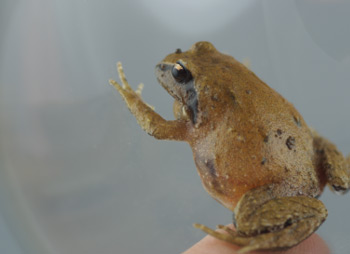 Springbrook Rescue
Springbrook Rescue
 Springbrook Rescue
Springbrook Rescue
| Home | The Vision | Springbrook — A Natural Wonder | The Springbrook Rescue Project | Support the Project | About ARCS |
Menu
| |
|
Springbrook’s fauna Springbrook’s rainforests are home to numerous species of fauna that are of outstanding significance to conservation and contribute to the World Heritage values. Just a few are described here. Little is known about the Springbrook populations of these fauna and whether they have declined owing to loss of habitat. Taking a precautionary approach, it may be critical to increase the area of closed-canopy forest to expand their habitat and to reduce clearings for houses, roads and transmission lines to reduce fragmentation. |
|
Albert’s Lyrebird (Menura alberti) Albert’s Lyrebirds can live to more than 40 years and are incredible songsters and mimics. |
 Photo: Kimbal Curtis |
||
|
Rufous Scrub-bird (Atrichornis rufescens) As noted above, scrub-birds and lyrebirds are the oldest line of songbirds in the world. As for lyrebirds, there are just two species of scrub-bird, Rufous and Noisy, with the latter occurring only in the southwest corner of Western Australia. The scrub-birds are so different from other birds that, like lyrebirds, they are placed in their own family. So, the only two species in the family are separated by 3500 kilometres! |
 Photo: Michael Morcombe |
||
|
Logrunner (Orthonyx temminckii) Logrunners evolved on the Australian landmass more than 25 million years ago. Fossils found at Riversleigh in northwestern Queensland and in cave deposits in Victoria and South Australia indicate they were widespread across eastern Australia at a time when it was covered with rainforest. As rainforest contracted, so too did the logrunners and today they are found only in central eastern Australia and New Guinea with another species in the genus, the Chowchilla, found only in the Wet Tropics of Queensland. |
 Photo: David Pavlacky |
||
|
Bowerbirds |

| ||
Southern Angle-headed Dragon (Lophosaurus spinipes) |
 Photo: Evan Peters |
||
|
Land Mullet Bellatorias major) Members of this genus and others in the Egernia group of skinks show strong social relationships, living in ‘nuclear family’ systems and forming long-term pair bonds. |
 Photo: Mark Ash |
||
 Photo: Aila Keto |
|||
|
Loveridge’s Frog or Masked Mountain Frog (Kyarranus loveridgei) |
 Photo: Keith Scott & Aila Keto |
||
|
Marsupial or Hip-pocket Frog (Assa darlingtoni) The Marsupial Frog is a rare species found only in high-altitude rainforests on the MacPherson Range in southeast Queensland and the adjoining Border Ranges area in New South Wales. It is almost unique in raising its young in ‘pockets’ on its flanks. Its nearest relative is in South America, indicating its Gondwanan origin. |
 Photo: H. Ehmann |
||
|
Black-soled Frog (Lechriodus fletcheri) Our camera-trapping recordings at Springbrook show that amplexus (mating) can last for 15 hours or longer. |
 Photo: Mark Ash |
||
|
Lamington Blue Spiny Crayfish (Euastacus sulcatus) Apart from this species, there are two other species, Euastacus maidae and Euastacus valentulus recorded from Springbrook National Park. Euastacus maidae is listed as critically endangered in the IUCN Red List. |
 Photo: Mark Ash |
||
| Pink Underwing Moth(Phyllodes imperialis) This impressive moth has a wingspan of up to 14 cm. The larvae (caterpillars) of this moth feed on the rainforest vine, Carronia multisepalea, which occurs only in southeast Queensland and northeast New South Wales. In fact, it is restricted to low (collapsed) forms rather than upright forms of the vine and only in undisturbed rainforest. This southern subspecies is listed as endangered.  Pink Underwing Moth caterpillar at Springbrook |
  Photo: Don Sands |
||
| Other fauna of interest Paradise Riflebird (Ptiloris paradiseus) Two species are endemic to Australia, Paradise Riflebird and Victoria’s Riflebird. The Paradise Riflebird is found only in rainforests on the central eastern coast while Victoria’s Riflebird is confined to the Wet Tropics of Queensland. Riflebirds are generally found high in the rainforest canopy. Males perform an elaborate courting display on branches well above the ground. |
 Photo: Ceris Ash |
||
|
Eastern Yellow Robin (Eopsaltria australis)  Photos: Evan Peters
Photos: Evan Peters
|
 Photo: Mark Ash |
||
|
Short-eared Brushtail Possum (Trichosurus caninus) The females and young are generally grey, but some males and, rarely, females develop striking jet black fur as in the photo. Based on our observations at Springbrook, they appear to be much more gentle and friendly than the Common Brushtail Possum and remain in family groups for several years. |
 Photo: Evan Peters |
||
|
Red-necked Pademelon (Thylogale thetis) Unfortunately, agencies responsible for road management maintain grassy verges that attract grazing pademelons. This leads to regular roadkills as they cross the road back to the forest. |
 Photo: Mark Ash |
||
|
Imperial Hairstreak Butterfly (Jalmenus evagoras) The whole life cycle occurs on species of Acacia, commonly smaller plants in regenerating areas. The top photo shows the butterflies and a pupa being attended by ants. The bottom photo shows pupae with some ants moving too fast for the camera to catch clearly. |
  Photos: Aila Keto |